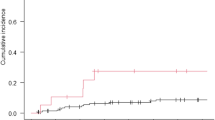Abstract
We aimed to assess the efficacy of stereotactic irradiation for patients with recurrent high-grade glioma (HGG) and identify predictive factors of progression-free survival (PFS) and overall survival (OS) following reirradiation. We identified 32 patients with recurrent brain HGG who had been treated with either single-dose (stereotactic radiosurgery) or fractionated stereotactic radiotherapy between April 2008 and October 2015. Median follow up was 21.4 months (range 12.9–23.2) and median PFS was and 3.3 months (95% CI [2.3–4.7]), respectively. OS was 90.40% (95% CI [73.09–96.80]) at 6 months and 79.55% (95% CI [59.9–90.29]) at 12 months. Univariate analysis showed that biological effective dose at isocenter ≤ 76 Gy was a poor prognostic factor for both OS (83.33 vs. 100% at 6 months, p = 0.032) and median PFS (2.7 vs. 4.7 months, p = 0.025), as was gross tumor volume (GTV) above 1 cm3 for OS (86.15 vs. 94.12% at 6 months, p = 0.043). Contact with the subventricular zone (SVZ) was also a poor prognostic factor for median PFS (2.3 vs. 4.7 months, p = 0.002). Multivariate analysis showed that SVZ contact remained a poor prognostic factor for PFS (hazard ratio = 3.44, 95% CI [1.21–9.82], p = 0.021). Results suggest that reirradiation is a safe and effective treatment option for recurrent HGG in patients with a good Karnosfsky Performance Scale score, a long progression-free interval since first radiation and limited GTV, and that contact to SVZ is a strong prognostic factor for PFS.

Similar content being viewed by others
References
Wen PY, Kesari S (2008) Malignant gliomas in adults. N Engl J Med 359:492–507. https://doi.org/10.1056/NEJMra0708126
Stupp R, Hegi ME, Mason WP et al (2009) Effects of radiotherapy with concomitant and adjuvant temozolomide versus radiotherapy alone on survival in glioblastoma in a randomised phase III study: 5-year analysis of the EORTC-NCIC trial. Lancet Oncol 10:459–466. https://doi.org/10.1016/S1470-2045(09)70025-7
Darefsky AS, King JT, Dubrow R (2012) Adult glioblastoma multiforme survival in the temozolomide era: a population-based analysis of surveillance, epidemiology, and end results registries. Cancer 118:2163–2172. https://doi.org/10.1002/cncr.26494
Koshy M, Villano JL, Dolecek TA et al (2012) Improved survival time trends for glioblastoma using the SEER 17 population-based registries. J Neurooncol 107:207–212. https://doi.org/10.1007/s11060-011-0738-7
Levin VA (1999) Chemotherapy for brain tumors of astrocytic and oligodendroglial lineage: the past decade and where we are heading. Neuro Oncol 1:69–80
Barbagallo GMV, Jenkinson MD, Brodbelt AR (2008) “Recurrent” glioblastoma multiforme, when should we reoperate? Br J Neurosurg 22:452–455. https://doi.org/10.1080/02688690802182256
Soults CB, Canute GS, Ryken TC (1998) Evidence-based review of the role of reoperation in the management of malignant glioma. Neurosurg Focus 4:e11
Weller M, van den Bent M, Hopkins K et al (2014) EANO guideline for the diagnosis and treatment of anaplastic gliomas and glioblastoma. Lancet Oncol 15:e395–e403. https://doi.org/10.1016/S1470-2045(14)70011-7
Amichetti M, Amelio D (2011) A review of the role of re-irradiation in recurrent high-grade glioma (HGG). Cancers 3:4061–4089. https://doi.org/10.3390/cancers3044061
Martínez-Carrillo M, Tovar-Martín I, Zurita-Herrera M et al (2014) Salvage radiosurgery for selected patients with recurrent malignant gliomas. Biomed Res Int 2014:657953. https://doi.org/10.1155/2014/657953
Ryu S, Buatti JM, Morris A et al (2014) The role of radiotherapy in the management of progressive glioblastoma: a systematic review and evidence-based clinical practice guideline. J Neurooncol 118:489–499. https://doi.org/10.1007/s11060-013-1337-6
Wen PY, Macdonald DR, Reardon DA et al (2010) Updated response assessment criteria for high-grade gliomas: response assessment in neuro-oncology working group. J Clin Oncol 28:1963–1972. https://doi.org/10.1200/JCO.2009.26.3541
Gupta T, Nair V, Jalali R (2014) Stem cell niche irradiation in glioblastoma: providing a ray of hope? CNS Oncol 3:367–376. https://doi.org/10.2217/cns.14.39
Lim DA, Cha S, Mayo MC et al (2007) Relationship of glioblastoma multiforme to neural stem cell regions predicts invasive and multifocal tumor phenotype. Neuro Oncol 9:424–429. https://doi.org/10.1215/15228517-2007-023
Adeberg S, König L, Bostel T et al (2014) Glioblastoma recurrence patterns after radiation therapy with regard to the subventricular zone. Int J Radiat Oncol Biol Phys 90:886–893. https://doi.org/10.1016/j.ijrobp.2014.07.027
Jafri NF, Clarke JL, Weinberg V et al (2013) Relationship of glioblastoma multiforme to the subventricular zone is associated with survival. Neuro Oncol 15:91–96. https://doi.org/10.1093/neuonc/nos268
Niyazi M, Siefert A, Schwarz SB et al (2011) Therapeutic options for recurrent malignant glioma. Radiother Oncol 98:1–14. https://doi.org/10.1016/j.radonc.2010.11.006
Elliott RE, Parker EC, Rush SC et al Efficacy of gamma knife radiosurgery for small-volume recurrent malignant gliomas after initial radical resection. World Neurosurg 76:128–140. https://doi.org/10.1016/j.wneu.2010.12.053. (discussion 61–62)
Kondziolka D, Flickinger JC, Bissonette DJ et al (1997) Survival benefit of stereotactic radiosurgery for patients with malignant glial neoplasms. Neurosurgery 41:776–783. (discussion 783–785)
Fogh SE, Andrews DW, Glass J et al (2010) Hypofractionated stereotactic radiation therapy: an effective therapy for recurrent high-grade gliomas. J Clin Oncol 28:3048–3053. https://doi.org/10.1200/JCO.2009.25.6941
Combs SE, Widmer V, Thilmann C et al (2005) Stereotactic radiosurgery (SRS). Cancer 104:2168–2173. https://doi.org/10.1002/cncr.21429
Shrieve DC, Alexander E, Wen PY et al (1995) Comparison of stereotactic radiosurgery and brachytherapy in the treatment of recurrent glioblastoma multiforme. Neurosurgery 36:275–282. (discussion 282–284)
Hsieh PC, Chandler JP, Bhangoo S et al (2005) Adjuvant gamma knife stereotactic radiosurgery at the time of tumor progression potentially improves survival for patients with glioblastoma multiforme. Neurosurgery 57:684–692
Mahajan A, McCutcheon IE, Suki D et al (2005) Case-control study of stereotactic radiosurgery for recurrent glioblastoma multiforme. J Neurosurg 103:210–217. https://doi.org/10.3171/jns.2005.103.2.0210
Kong D-S, Lee J-I, Park K et al (2008) Efficacy of stereotactic radiosurgery as a salvage treatment for recurrent malignant gliomas. Cancer 112:2046–2051. https://doi.org/10.1002/cncr.23402
Combs SE, Edler L, Rausch R et al (2013) Generation and validation of a prognostic score to predict outcome after re-irradiation of recurrent glioma. Acta Oncol 52:147–152. https://doi.org/10.3109/0284186X.2012.692882
Niyazi M, Flieger M, Ganswindt U et al (2014) Validation of the prognostic Heidelberg re-irradiation score in an independent mono-institutional patient cohort. Radiat Oncol 9:128. https://doi.org/10.1186/1748-717X-9-128
Larson DA, Gutin PH, McDermott M et al (1996) Gamma knife for glioma: selection factors and survival. Int J Radiat Oncol Biol Phys 36:1045–1053
Lederman G, Wronski M, Arbit E et al (2000) Treatment of recurrent glioblastoma multiforme using fractionated stereotactic radiosurgery and concurrent paclitaxel. Am J Clin Oncol 23:155–159
Noël G, Ben Ammar CN, Feuvret L et al (2004) Results of salvage stereotactic radiosurgery in 14 patients with grade III or IV gliomas. Rev Neurol (Paris) 160:539–545
Cho KH, Hall WA, Gerbi BJ et al (1999) Single dose versus fractionated stereotactic radiotherapy for recurrent high-grade gliomas. Int J Radiat Oncol Biol Phys 45:1133–1141
Fokas E, Wacker U, Gross MW et al (2009) Hypofractionated stereotactic reirradiation of recurrent glioblastomas: a beneficial treatment option after high-dose radiotherapy? Strahlenther Onkol 185:235–240. https://doi.org/10.1007/s00066-009-1753-x
Quiñones-Hinojosa A, Chaichana K (2007) The human subventricular zone: a source of new cells and a potential source of brain tumors. Exp Neurol 205:313–324. https://doi.org/10.1016/j.expneurol.2007.03.016
Doetsch F, Caillé I, Lim DA et al (1999) Subventricular zone astrocytes are neural stem cells in the adult mammalian brain. Cell 97:703–716
Alvarez-Buylla A, Garcia-Verdugo JM (2002) Neurogenesis in adult subventricular zone. J Neurosci 22:629–634
Adeberg S, Bostel T, König L et al (2014) A comparison of long-term survivors and short-term survivors with glioblastoma, subventricular zone involvement: a predictive factor for survival? Radiat Oncol 9:95. https://doi.org/10.1186/1748-717X-9-95
Chaichana KL, McGirt MJ, Frazier J et al (2008) Relationship of glioblastoma multiforme to the lateral ventricles predicts survival following tumor resection. J Neurooncol 89:219–224. https://doi.org/10.1007/s11060-008-9609-2
Aguirre A, Gallo V (2004) Postnatal neurogenesis and gliogenesis in the olfactory bulb from NG2-expressing progenitors of the subventricular zone. J Neurosci 24:10530–10541. https://doi.org/10.1523/JNEUROSCI.3572-04.2004
Evers P, Lee PP, DeMarco J et al (2010) Irradiation of the potential cancer stem cell niches in the adult brain improves progression-free survival of patients with malignant glioma. BMC Cancer 10:384. https://doi.org/10.1186/1471-2407-10-384
Slotman BJ, Eppinga WSC, de Haan PF, Lagerwaard FJ (2011) Is irradiation of potential cancer stem cell niches in the subventricular zones indicated in GBM? Int J Radiat Oncol 81:S184. https://doi.org/10.1016/j.ijrobp.2011.06.328
Gupta T, Nair V, Paul SN et al (2012) Can irradiation of potential cancer stem-cell niche in the subventricular zone influence survival in patients with newly diagnosed glioblastoma? J Neurooncol 109:195–203. https://doi.org/10.1007/s11060-012-0887-3
Chen L, Guerrero-Cazares H, Ye X et al (2013) Increased subventricular zone radiation dose correlates with survival in glioblastoma patients after gross total resection. Int J Radiat Oncol Biol Phys 86:616–622. https://doi.org/10.1016/j.ijrobp.2013.02.014
Elicin O, Inac E, Uzel EK et al (2014) Relationship between survival and increased radiation dose to subventricular zone in glioblastoma is controversial. J Neurooncol 118:413–419. https://doi.org/10.1007/s11060-014-1424-3
Lee P, Eppinga W, Lagerwaard F et al (2013) Evaluation of high ipsilateral subventricular zone radiation therapy dose in glioblastoma: a pooled analysis. Int J Radiat Oncol Biol Phys 86:609–615. https://doi.org/10.1016/j.ijrobp.2013.01.009
Khalifa J, Tensaouti F, Lusque A et al (2017) Subventricular zones: new key targets for glioblastoma treatment. Radiat Oncol 12:67. https://doi.org/10.1186/s13014-017-0791-2
Ellison DW, Kocak M, Figarella-Branger D et al (2011) Histopathological grading of pediatric ependymoma: reproducibility and clinical relevance in European trial cohorts. J Negat Results Biomed 10:7. https://doi.org/10.1186/1477-5751-10-7
Louis DN, Perry A, Reifenberger G et al (2016) The 2016 world health organization classification of tumors of the central nervous system: a summary. Acta Neuropathol 131:803–820. https://doi.org/10.1007/s00401-016-1545-1
Flieger M, Ganswindt U, Schwarz SB et al (2014) Re-irradiation and bevacizumab in recurrent high-grade glioma: an effective treatment option. J Neurooncol 117:337–345. https://doi.org/10.1007/s11060-014-1394-5
Khasraw M, Ameratunga M, Grommes C (2014) Bevacizumab for the treatment of high-grade glioma: an update after phase III trials. Expert Opin Biol Ther 14:729–740. https://doi.org/10.1517/14712598.2014.898060
Hundsberger T, Brügge D, Putora PM et al (2013) Re-irradiation with and without bevacizumab as salvage therapy for recurrent or progressive high-grade gliomas. J Neurooncol 112:133–139. https://doi.org/10.1007/s11060-013-1044-3
Author information
Authors and Affiliations
Corresponding author
Ethics declarations
Conflict of interest
The authors have no conflict of interest.
Rights and permissions
About this article
Cite this article
Attal, J., Chaltiel, L., Lubrano, V. et al. Subventricular zone involvement at recurrence is a strong predictive factor of outcome following high grade glioma reirradiation. J Neurooncol 136, 413–419 (2018). https://doi.org/10.1007/s11060-017-2669-4
Received:
Accepted:
Published:
Issue Date:
DOI: https://doi.org/10.1007/s11060-017-2669-4




